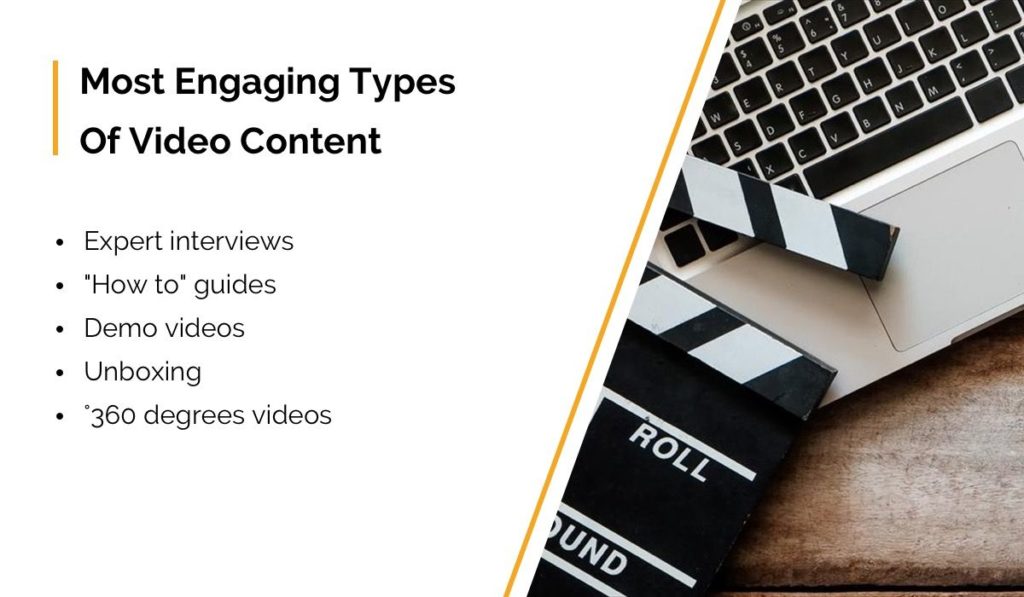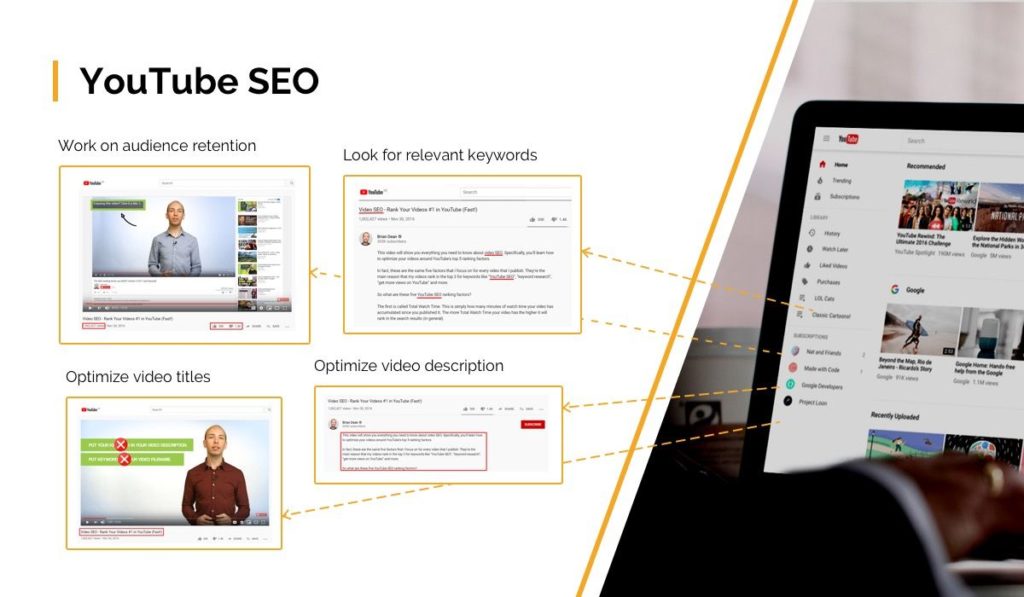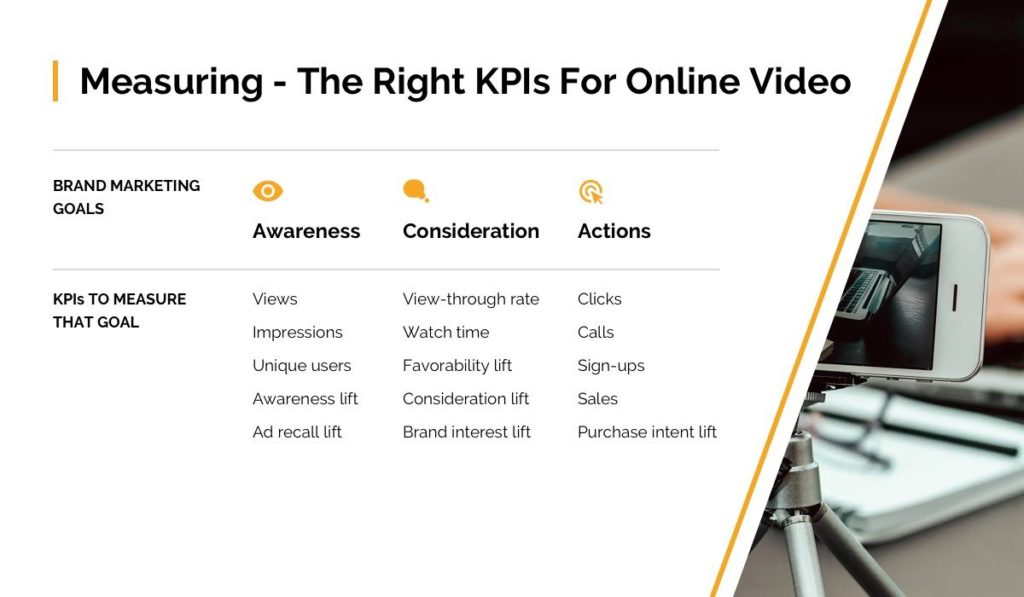
7 Must-Have Elements of a Killer Video Marketing Strategy
If you’re reading this post, then you’re probably looking for actionable advice on how to boost your business with video marketing. This is a clever move. According to Smart Insights, the marketers who already use video marketing will continue to do so in 2020. Along with that, 59% of marketers are planning to include videos to their marketing strategy. Feel like jumping on this bandwagon?
In this post, we’ll guide you through the process of building your video marketing strategy from the ground up to measure the results. Let’s dive in!
1. Set goals for your content
Marketing is the science that likes figures and numbers (who doesn’t?), so goal setting is a must for your video marketing strategy. The key idea here is to create content for every stage of a marketing funnel.
Let’s take a buyer’s journey, for example. It consists of three stages:
- Awareness
- Consideration
- Decision
Each stage is characterised by specific behaviour patterns and the audience’s needs. By considering those needs, you’ll be able to create your video content.
At the Awareness stage, people realise they’ve got a problem, but their focus is too broad. Their search query might be something like this: “the best New Year’s present for girls.” Your goal is to attract new users, build their trust, and engage with them. For this stage, it’s efficient to create educational content like guides, useful tips, infographics, and trivia.
The next stage is the Consideration. At this stage, people start to compare the options, for example: “iPhone 11 vs iPhone 11 Pro review.” Opt for content like comparison videos, newsletters, and reviews to help people decide. You must reinforce your expert reputation among your audience and help users solve their issues.
Webinars can perfectly serve this purpose. Make sure you set goals like acquiring new users, pushing them forward in the sales funnel, and slightly give a hint that you’re the right vendor to buy from.
Finally, at the Decision, when people are ready to make a purchase, move into play and offer demos, brand videos, testimonials from clients, case studies, etc. Your goal here is to provide social proof, convince a viewer that you’re the right vendor, and make a sales pitch.
2. Choose the content format
Next, you need to pick the right content format. It’s necessary to be able to communicate even a commercial message in an engaging, relevant form. Remember the rule of thumb: “tell, don’t sell” and choose what works best for you:

- Expert interviews – if you’re selling educational content or building a personal brand, opt for interviews with experts and thought leaders from your industry. Thus you’ll be able to build users’ trust and increase your authority.
- “How to” guides – “How to” perfectly fit into an SEO optimisation strategy because users tend to search for information with such kinds of requests. Use “how-to” videos to educate and entertain your audience. Keep in mind that such guides are relevant for an Awareness stage of a buyer’s journey when people simply research information and don’t expect direct sales.
- Demo videos – this format is just right for businesses that sell products. You can showcase the items, test them, and demonstrate them in use to stir the interest of a target audience.
- Unboxing – this is a similar format to a demo, but a more natural one. Beauty and apparel brands collaborate with video bloggers to create unboxing videos. In such a way, you’re able to showcase the product and “hide” it in an informal and funny piece of content.
- 360 degrees videos – such videos showcase the products from different angles, usually on a white or light background in order not to distract people from the item. Retailers like Zappos, 6 pm, and Shopbop use such videos to demonstrate apparel, shoes, and accessories on their websites.
3. Select the right platform
Guess what – YouTube isn’t the only platform for video marketing, even though it’s the most popular one. In fact, there are other social media video platforms worth considering:
- Facebook Watch – in order not to stay behind, Facebook launched its own video platform. Their idea is to bring people together with group watching of synchronised videos, so every member watches content at the same time. Utilising Facebook Watch is reasonable if you want to engage with your audience, build a local community, etc.
- IGTV by Instagram – Instagram expanded its content formats with long-form videos in 2018. IGTV is a winning strategy for those who already have a loyal audience on their Instagram accounts. With IGTV, you can expand your audience to reach and engage with the people on-the-go.
Related Read: How to Maximise Instagram for Business
- Snapchat – it’s popular among 13-24 year-olds making it a perfect tool to reach that specific demographic, though the spending potential of such an audience is usually low. So, selling goods and services on Snapchat might not be a good idea.
- TikTok – this platform is gaining popularity among youngsters and millennials with light speed. In 2019, TikTok became the third most downloadable app in the world. Just like Snapchat, TikTok is an app that is difficult to monetise.
- Vimeo – this platform has a vibrant community of video makers. They even created built-in tools for video editing and provided an option of hiring professionals to avoid hassle with content production.
The bottom line: choose the platform popular among your target audience. While platforms like YouTube and IGTV cover multiple types of demographics, TikTok and Snapchat may help you target a specific audience.
4. Decide who’ll create video content
There are several options to consider when it comes to deciding who’ll create video content.
First, you can craft video content with your internal team. This approach has its benefits. You can develop and keep the expertise inside the team, communicate frequently, and quickly change the marketing strategy if necessary.
However, it might be a challenge to keep up with decent quality and professional production. For Zappos, it’s not an issue. Their employees record product reviews in a casual, cheerful manner. They also use funny nicknames like Sunshine and Autumn to lift the mood.
Second, you can hire an external professional or team. In this case, you can take your video content to another level with high-quality production, animations, effects, and so on. If your target audience is demanding and expects impressive content, it makes sense to hire professionals.
Finally, you can team up with bloggers or influencers that’ll create content for you. Such collaboration can be fruitful since you can attract the blogger’s audience and expand your reach.
For example, Morphe cosmetics brand collaborated with James Charles, a blogger with 17.7 million subscribers (while you’re reading this, there might be even more!) to film product reviews and makeup lessons.
5. Optimise your videos for search engines
Text content like blog posts is not the only marketing tool that needs SEO. Video content can (and should) be optimised for search engines as well. Let’s see how you can optimise your YouTube videos for better rankings. Why YouTube? Because it’s the second largest search engine after Google.
Here’s what you can do to ensure your video ranks in the top:

- Look for relevant keywords – we are not suggesting you stuff your video descriptions with keywords. But, keywords help your users find your content and rank at the top. Look for keywords in Ahrefs or similar tools. That’s how you can find out their search volume and assess the difficulty of getting to the top with a keyword.
- Optimise video title – experts claim that just like with text content, placing a keyword closer to the beginning of the video title gives you a slight boost. Be careful and don’t pack your title with keywords. At least 5 words in your title will help you create an organically SEO-optimised text.
- Optimise your video description – as for video description, YouTube marketers recommend keeping it concise and short (up to 250 words). Again, place the keywords in the first 25 words and include them several times for better rankings.
- Work on Audience Retention – One of the essential factors is Audience Retention – the number of video people is watching. According to YouTube, the Audience Retention rate must be as close to 100% as possible. Besides, the audience’s activity also counts. Comments, likes, subscriptions, and transitions to another video help your YouTube video rank higher.
6. Distribute the video content
The strategies for content distribution can be divided into three groups.
- There’s owned media like your website, blog, social media accounts, and emails. This way of promotion has its pros: it’s basically free and you’re fully in control. But as a rule, the company’s communication isn’t as trusted as communication via earned media.
- When customers become your distribution channel, this means you’ve got earned media. Earned media includes social shares, mentions, reposts, and reviews. While earned media is credible and plays a significant role in sales, the results are hard to measure and scale. However, you can simplify and automate this process by using some social media suites which will help you manage, track and analyze your earned media metrics.
- Finally, there’s paid media: paid advertisement, sponsorships, PPC, paid influencers and affiliates, etc. The benefit of paid media is being in control (you can moderate the audience’s activity), ability to scale, and creating the demand. However, paid media is characterized by poor credibility and might be pricey.
7. Measure your success
Last but not least is measuring the success of your video marketing strategy. When it comes to metrics, it’s important to distinguish vanity and actionable metrics.
Vanity metrics are tricky. They may look good and shift your focus to insignificant markers. For example, vanity metrics include likes, followers, branded search lift, etc. Such metrics usually don’t represent a direct impact on your business.
What you have to measure is actionable metrics. The actionable metrics provide you with useful insights and allow you to make impactful conclusions. They include video clicks, view-through rate, watch time, etc.
Here are the metrics Google recommends to measure:

To recap
Just like with any other type of marketing, it’s important to set goals for your video content, craft the content that appeals to your target audience, and measure the success of your campaigns. Keep out vanity metrics like comments and likes that may fool you. Happy video marketing!
You read a lot. We like that
Want to take your online business to the next level? Get the tips and insights that matter.


